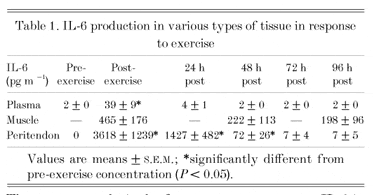Plasma interleukin-6 (IL-6) has been shown to increase during prolonged exercise, sepsis and major trauma (Pedersen et al. 2001), and studies have debated whether the net production of IL-6 in skeletal muscle could account for the rise in plasma IL-6 (Steensberg et al. 2000; Starkie et al. 2001). However, many different cells are known to produce IL-6 such as monocytes/macrophages, fibroblasts, and vascular endothelial cells. In the present study we measured IL-6 concentration around a tendon and in a skeletal muscle before, immediately after, and every day during the following 4 days after a 36 km run (12 km h-1).
Healthy well-trained volunteers (n = 6 males, age: 30 ± 3 years) participated after giving informed consent in the present study which was approved by the Ethical Committee of Copenhagen ((KF)01-215/99). Microdialysis catheters with a high molecular mass cut-off value (3000 kDa, flow rate: 5 µl min-1) were positioned in the peritendon (Achilles tendon) and in m. gastrocnemius med. under ultrasound guidance. Relative recovery of the microdialysis fibres was measured using [3H]-human type IV collagen (130 kDa).
Statistical analysis with Friedman’s test for repeated measures and subsequent Wilcoxon’s signed rank tests was used.
The present study is the first attempt to measure IL-6 in plasma, muscle and the peritendon area simultaneously. As shown in Table 1, a dramatic increase in peritendinous tissue concentration was observed peaking immediately after exercise, whereas muscle concentration did not change significantly in the post-exercise phase. This study indicates that the peritendinous tissue represents an IL-6 producing region with exercise, and suggests that it contributes to the rise in IL-6 concentration observed in plasma in response to exercise.

